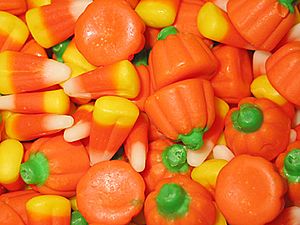Candy pumpkin facts for kids

Candy corn and candy pumpkins
|
|
| Type | Confectionery |
|---|---|
| Place of origin | United States |
| Main ingredients | Corn syrup, honey, carnauba wax, sugar |
A candy pumpkin is a small, pumpkin-shaped sweet treat. It's a type of candy called "mellow crème." This means it has a soft, creamy texture and a flavor like marshmallow.
Candy pumpkins are mostly made from corn syrup, honey, a bit of carnauba wax, and sugar. They are usually bright orange with a green stem. This makes them easy to spot as a special treat for Halloween. Many people think of them as a "cousin" to candy corn. The most famous candy pumpkin is called "Mellowcreme Pumpkin" by Brach's candy company.
How Candy Pumpkins Are Made
Candy pumpkins are made in a way that's very similar to how candy corn is created. This special process was first used in the 1880s by George Renninger for candy corn. Candy pumpkins started being made in the mid-1900s.
Here's how they get their sweet, creamy texture:
- First, corn syrup, food coloring, honey, and sugar are mixed and heated in big kettles. This makes a super sweet, thick syrup.
- Confectioners (candy makers) call this syrup "mellow crème." It's because the candy that comes from it is soft and creamy.
- Next, the mellow crème mix is divided. Most of it gets orange food coloring. A smaller part gets green coloring for the stem.
- A special machine called a "mogul machine" helps put these two colored mixtures into molds. These molds are made from cornstarch.
- The candies then go into a drying room. They stay there for about 24 to 36 hours to dry out.
- Once they are dry, the candies are gently shaken. This removes any extra cornstarch.
- Finally, a shiny glaze is added. This gives the candy pumpkin its bright, finished look.
Sometimes, candy pumpkins are sold with candy corn and other mellow crème shapes, like acorns. This mix is often called "harvest mix."
Why Candy Pumpkins Are So Popular
Candy pumpkins are loved by many people. One reason is their "interesting texture," which is soft and creamy. In the past, not many big candy companies made special Halloween treats. But Brach's Confections was an exception. They made candy pumpkins and other seasonal candies.
Brach's "Mellowcreme Pumpkin" was designed to look like a fall fruit. Each little pumpkin has about 25 calories and 5 grams of sugar. In 1992, Brach's thought they would sell over 30 million pounds of mellow crème candy during the fall season! This included their popular pumpkins.
By the late 1990s, other candy companies saw how popular candy pumpkins were becoming. They realized that the market for special Halloween candy was growing fast.
- For example, in 1997, candy pumpkins and other mellow crème candies helped push the total spending on Halloween candy in the United States to about $950 million a year!
- In response, companies like Mars, Incorporated started making their own Halloween treats. In 1998, Mars came out with "Snickers Crème Pumpkin." This was a milk chocolate-covered peanut and caramel candy. It came in a wrapper with a Jack-o'-lantern on it.
- Later, in 2000, the Frankford Candy & Chocolate Company teamed up with ConAgra Foods. They made "Peter Pan Peanut Butter Pumpkins." These had a creamy Peter Pan peanut butter center shaped like a pumpkin.
- Also in 2000, Zachary Confections added candy pumpkins to their product line.
Candy Pumpkins and Daylight Saving Time
Candy pumpkins even played a small part in how daylight saving time works in the U.S. today! Since the 1960s, candy makers wanted the trick-or-treat period to happen during daylight saving time. They thought that if kids had an extra hour of daylight, they would collect more candy.
During a U.S. Congress meeting in 1985 about Daylight Saving, the candy industry tried to get senators on their side. They even put candy pumpkins on the seat of every senator!
At first, a law signed in 1986 by President Ronald Reagan didn't quite include Halloween night in daylight saving time. But in 2005, the law was changed. Daylight saving time was extended to the first Sunday in November. This was just long enough to include Halloween!

